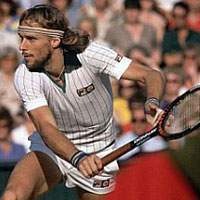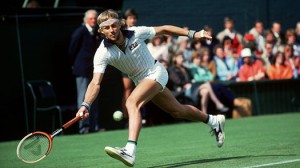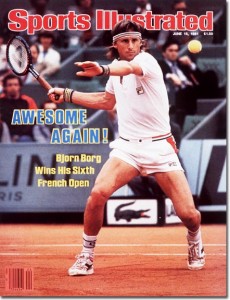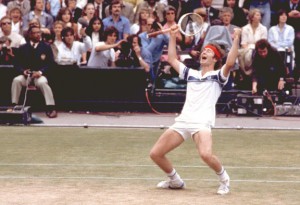Bjorn Borg: The Beginning of the End, Part Two

Bjorn Borg was the face of tennis in the late 1970s.
For Bjorn Borg, the summer of 1980 was a time of highs and lows, of thrilling victory followed by stunning defeat.
His holding pattern persisted, as Borg, who won three consecutive doubles at the French Open and Wimbledon, lost his bid again for a chance at a calendar-year Grand Slam at the conclusion of 1980’s season in the sun.
During that sultry summer, two men met on fateful Sundays in July and in September to tighten the screw on Borg’s legacy. After 10 U.S. Opens, Borg sensed that his time to win this elusive Grand Slam was slipping away. He looked across the net at the up-and-coming John McEnroe and felt his tennis future fading.
His first awareness came during the fabulous 1980 Wimbledon final, when Borg confronted an odd sensation—fear of losing, of surrendering his dominance. For Borg, the certainty that he would win was a constant. Luckily, he was able shake off the feeling and seal the victory in set five, capturing his fifth consecutive Wimbledon championship.
But the sinking sensation returned during the U.S. Open final of 1980, as Borg lost in five sets, 7-6, 6-1, 6-7, 5-7, 6-4. Borg needed to win the Open and shake the monkey off his back. New York, however, remained foreign, bizarre, and unattainable, as Borg packed his gear and headed home after being shut out once again at the Big Apple.

Borg entered 1981 clinging to a slight advantage over John McEnroe despite losing in the finals of the 1980 U.S. Open.
He shook off the loss eventually and, even though uncharacteristically flat-footed, went on to defeat his main adversary, John McEnroe, in the final of the 1980 Stockholm Open, 6–3, 6–4.
Then in round-robin play at the year-end Masters in January of 1981, Borg faced McEnroe again. With over 19,000 fans in attendance, Borg defeated McEnroe in a deciding third-set tie-break for the second year in a row, 6–4, 6–7, 7–6 (3). Borg went on to win his second masters title by defeating Ivan Lendl, 6–4, 6–2, 6–2.
It seemed all his energy and enthusiasm were peaking in time for the 1981 French Open, where Borg would be attempting to win his fourth title in a row and his sixth overall. The clay seemed to imbue Borg with renewed power and supremacy.

Borg's last Grand Slam title was the 1981 French Open.
“The year begins in Paris,” Borg confidently told The New York Times as the tournament got underway.
Indeed, Borg was true to form and went on to win his last Grand Slam tournament by defeating Ivan Lendl in the final, 6-1, 4-6, 6-2, 3-6, 6-1 in three and a quarter hours. It was a tough match for Borg, who was accustomed to defeating his opponents more readily on the red clay.
Borg played a masterful match against the young Czech by slowing down the pace and pestering Lendl with accurate, deep shots until he wore him down.
After playing few matches in early 1981 and losing in early rounds at most, there was much speculation about the future prospects of the talented Swede.
There was the question of his right shoulder injury. Borg said he was slowing down, playing less to rest his injured wing. But in the meantime, the rumor mill pumped out the usual: Borg was going to quit and settle down with his new wife to raise a family.
Often the buzz painted Borg as growing apathetic and lazy. Some even hinted he was growing senile. The press grew impatient for an answer.
Luckily for Borg, the weather and the draw cooperated—Paris did not sizzle during the 1981 French Open. Rain interrupted play so often that at one point Borg was ahead of most other players by two rounds. It was strange that the tennis gods held back the deluge until Borg’s matches were complete.
This allowed Borg time to recover and recoup while his shoulder mended and the Swede could work his way into the tournament.
Borg’s victory at the 1981 French Open silenced the critics and the skeptics for the time being as he prepared for another double (his fourth) by taking the Wimbledon championship for the sixth year in a row.
The 1981 Wimbledon crown allowed Borg another run at a Grand Slam. Already the crowds were looking forward to a repeat of a Borg-McEnroe battle—reflecting back to the war waged on Centre Court in 1980.
So it was on another fateful Sunday, the tennis gods pitted the two best players on the planet on Centre Court with the winner to take it all—Bjorn Borg vs. John McEnroe, Act Two.
It looked like business as usual in the first set. Borg planted himself behind the baseline and waited for McEnroe’s serve, as was his custom. In the fifth game, he broke McEnroe to take a 3-2 lead. It was all Borg needed. He took the first set, 6-4.

John McEnroe ended Borg's run at Wimbledon in the 1981 Finals.
Borg continued to dominate, making life tough for the antsy American, but McEnroe held on to make it 3-3 in the second set. The two players had been on court for an hour but the match had not yet begun.
McEnroe had numerous chances to put the second set away—nine break points worth—but he failed to convert and the set went to a tie-break. It was in the tie-break that McEnroe found the power of his serve. He won it, 7-1, in the blink of an eye with Princess Grace of Monaco (Grace Kelly) watching from the Royal Box.
The match was all tied up, one set each.
The third set was anybody’s to call. For the first part of it, Borg was perfect, error-free, and composed. Inevitably, however, he failed to win the big points when he needed to. Even when McEnroe double-faulted, losing the fourth game, and Borg held serve to go up 4-1, he could not take the set.
McEnroe held his serve then came back to break Borg in the seventh game. It was the first of 11 break opportunities that McEnroe won. The next crucial game required 12 points, with McEnroe squeaking by, even after double-faulting twice.
Borg held to go up 5-4. That is when the insanity began. In the 10th game, a ball that landed on the baseline was called good, then overruled by umpire Bob Jenkins. It allowed Borg to go up 40-15 on McEnroe’s serve—giving him a chance to take the set.
The crowd silenced waiting for the volatile McEnroe to explode. Normally, the sky would be filled with expletives after such a move by the umpire. Instead, McEnroe bent over standing at the baseline, shaking his head, breathing deeply.
Then he fired two aces at Borg, who stood watching them ricochet past. That brought the game back to deuce. McEnroe lived to fight off another set point—then took the game when Borg sent a forehand into the net.
Later, McEnroe admitted “I didn’t erupt because it takes too much out of you to play Borg.” He also admitted that he restrained his reaction because of his respect for the man across the net—the Borg man.
They went to a third-set tie-break, which McEnroe took, 7-4. The left-handed serve was giving Borg nightmares as he often stood near the doubles alley trying to return. Borg was now 0-3 in Wimbledon final tie-breaks, his losses all to McEnroe.
Up two sets to one, McEnroe was determined not to allow Borg back into the match. He wanted no repeat of 1980. Finally, McEnroe had seized control of the match, serving extremely well, and Borg was no longer sure that he would defeat the brash young American.
Borg had two break points in the third game, but could convert neither. In all of his 15 break point chances in the match, Borg only converted twice.
Both contestants managed to hang onto his serve until the 10th game, where Borg, trailing 5-4, finally lost a match at Wimbledon as McEnroe broke his serve by sending a volley down the line and out of Borg’s reach.
The crowd applauded politely. They had, of course, backed Borg to win his sixth championship. Even Borg said “No one can win forever.”
His fear had come home to roost. McEnroe was the new champion and the new No. 1 player. But the rivalry was not over—not quite yet. The two would meet once again in the finals of New York for the last time…
Click Here to read Part One
Stay Tuned for Part Three
JA Allen is a regular contributor to Sports Then and Now